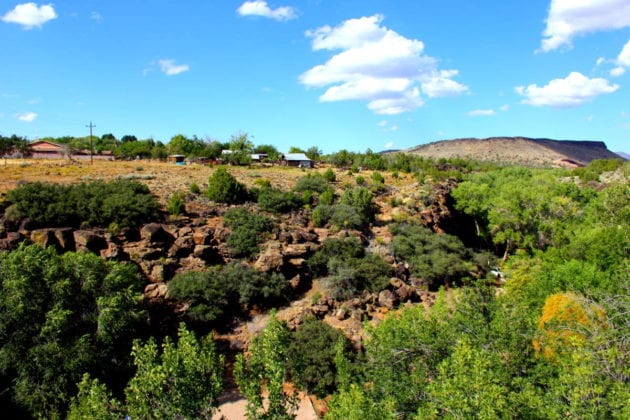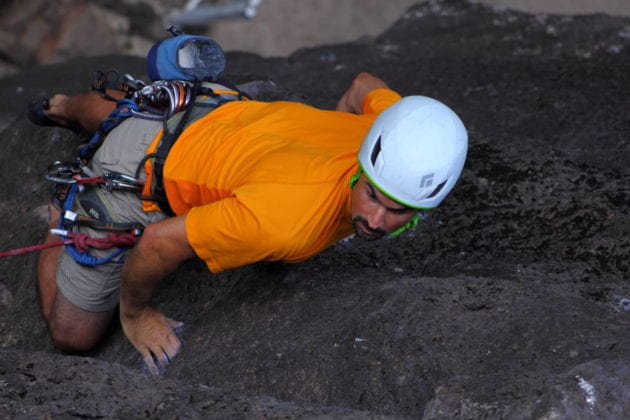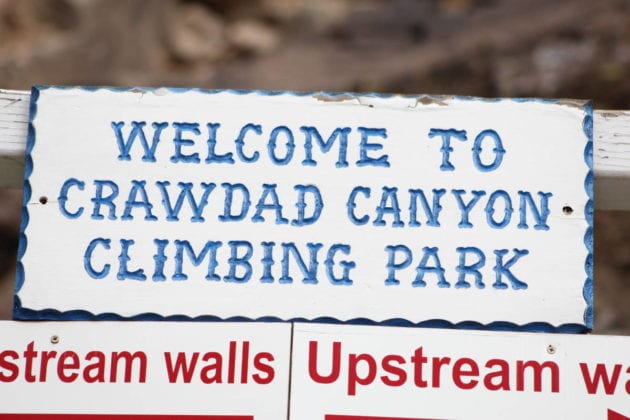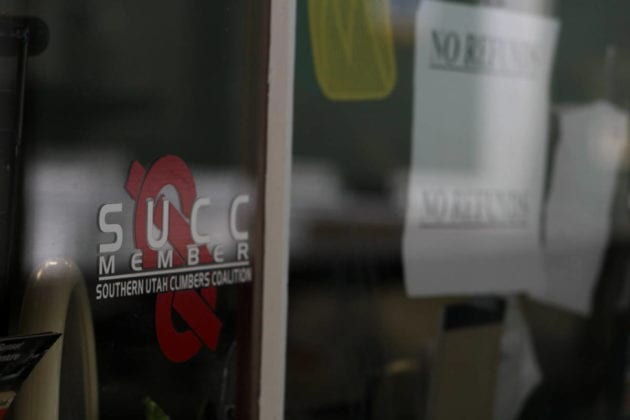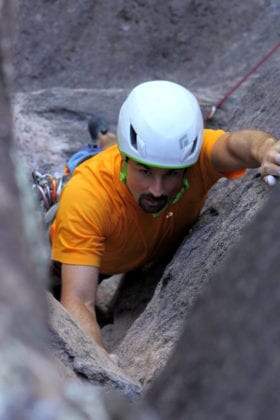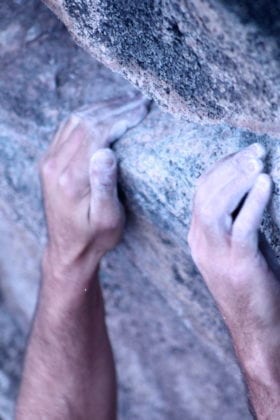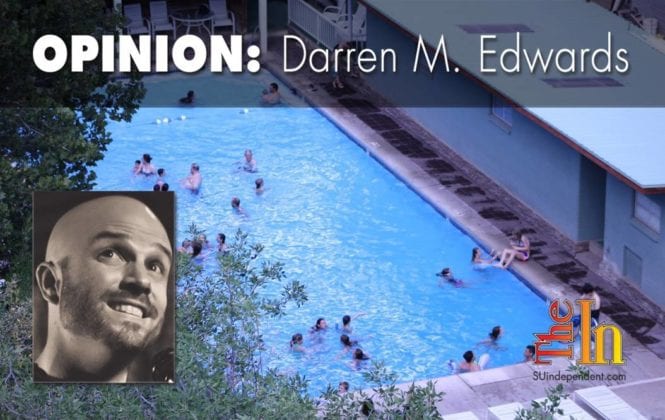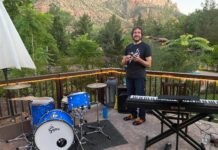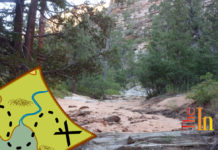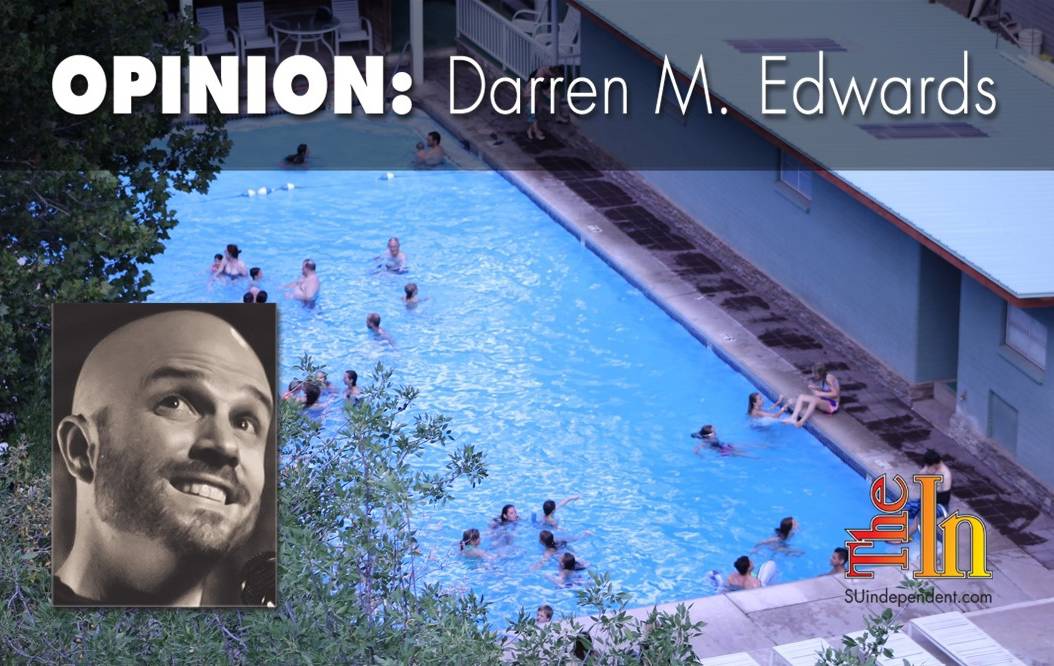
The first time I climbed in Crawdad Canyon was over 10 years and 40 pounds ago. I was just pushing my way into the mid 5.11 range (a slightly above average difficulty rating according to the Yosemite decimal scale) with hopes of soon trying some 5.12 range (at the time, I found the general feeling among those the climbers I knew was that 5.12 marked the start of “expert” climbing, and I wanted to consider myself expert really goddamned bad). The trip was part of a rock climbing vacation I took with a handful of good friends, a trip which ended with me nearly getting decapitated by a sandstone roof at the Green Valley Gap, a deep V carved into flat land on the west edge of St. George. Unlike Green Valley Gap, Crawdad Canyon is a wooded wonderland dropped like some magical oasis in the middle of the Southern Utah desert, a wash of greens, dark browns, and blues hidden within an expanse of orange and red.
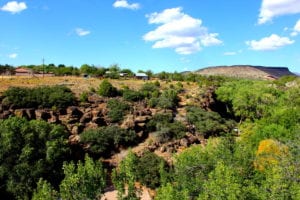
After parking in the paved lot that sits above both the canyon and Veyo Pool, climbers take a short walk down a steep road that drops them into this oasis. Shade from cottonwood trees covers everything. A creek, I shit you not, babbles through the middle of the canyon. The air practically vibrates with bird song, and if a talking deer and bunny were to greet me with enthusiastic jazz hands … well, okay, that might actually catch me off guard. As Susan Bosse Attwell, the canyon’s current owner, notes, “It’s nice. It’s usually at least 10 degrees cooler down here than up on top.” In an area where ten degrees can make the difference between double and triple digits, that drop is welcomed.
Before entering the actual canyon, there is an entrance to Veyo Pool on the left where all climbers must check in, pay the $9 entrance fee, and sign a waiver.  This is the same place climbers and sunbathers can pay for chicken strips or corn pone should the mood strike them. The canyon itself boasts over 180 bolted climbs ranging from 5.6 (beginner) to 5.13 (I can only dream about). These routes are found on dark basalt walls that can reach up to 80 feet. For the Red Rocks and Zion group, 80 feet probably sounds like standing on top of an ant hill, but for a lot of us ants that number feels just right. We, and by that I mean me and nearly every one I’ve ever sport-climbed with (or bouldered with for that matter) don’t find our high from the adventure of placing gear on the eighth pitch of 700-foot peak (though, I’d imagine that situation would also provide a very real high). We find it in inches. We find it in the challenges the stone can give us in the reach for each hold, each high-step, gaston, and crimp regardless of our distance from the ground.
This is the same place climbers and sunbathers can pay for chicken strips or corn pone should the mood strike them. The canyon itself boasts over 180 bolted climbs ranging from 5.6 (beginner) to 5.13 (I can only dream about). These routes are found on dark basalt walls that can reach up to 80 feet. For the Red Rocks and Zion group, 80 feet probably sounds like standing on top of an ant hill, but for a lot of us ants that number feels just right. We, and by that I mean me and nearly every one I’ve ever sport-climbed with (or bouldered with for that matter) don’t find our high from the adventure of placing gear on the eighth pitch of 700-foot peak (though, I’d imagine that situation would also provide a very real high). We find it in inches. We find it in the challenges the stone can give us in the reach for each hold, each high-step, gaston, and crimp regardless of our distance from the ground.
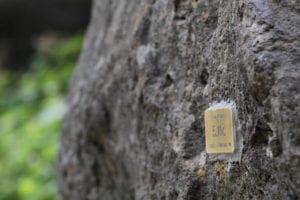
Crawdad Canyon is one of the only places, if not the only place, you’ll find route identification plaques at the base of each climbing which provide the routes name, difficulty rating, and the name of the climber who claimed the first assent. Climbers will also find belay benches at the base of some climbs.
![]()
![]() Veyo Pool and Crawdad Canyon are a favorite destination for locals (non-climbers) and have been for around 80 years. In the summers, Bosse Attwell likes to stay at the canyon where she can walk around, usually unrecognized, and overhear the comments campers make. She notices the children crouched along the bank of the creek trying to catch the crawdads the canyon is named for. “It’s a simple thing,” she notes. “There are thousands of them in there. But that’s a simple pleasure at a magical age. Those things that happen at that age, they’re going to remember forever.” Time has proven her statement true. Among the things she often hears are comments made by those returning to Veyo Pool and Crawdad Canyon decades after their first visit, often with grandchildren in tow. She points out that all of these comments are made with a specific enthusiasm. I’d imagine the kind that comes from handing a piece of your past to a future generation.
Veyo Pool and Crawdad Canyon are a favorite destination for locals (non-climbers) and have been for around 80 years. In the summers, Bosse Attwell likes to stay at the canyon where she can walk around, usually unrecognized, and overhear the comments campers make. She notices the children crouched along the bank of the creek trying to catch the crawdads the canyon is named for. “It’s a simple thing,” she notes. “There are thousands of them in there. But that’s a simple pleasure at a magical age. Those things that happen at that age, they’re going to remember forever.” Time has proven her statement true. Among the things she often hears are comments made by those returning to Veyo Pool and Crawdad Canyon decades after their first visit, often with grandchildren in tow. She points out that all of these comments are made with a specific enthusiasm. I’d imagine the kind that comes from handing a piece of your past to a future generation.
The pool itself has an interesting history. Originally built by James and Caroline Cottam, who obtained the land through the Homestead Act, the first iteration of the pool was finished in 1927. The message board outside Veyo Pool which tells its history notes that James had to do the work himself since no engineers would go near the project. Within a year of completion, word of the unusual pool spread to the point that the 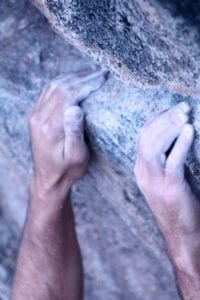 Cottam’s decided to change the pool from private to public. Over time, the Cottams added dressing rooms, an office building, picket fence, and even an orchestra pit. “It was the happening place,” says Morris, Susan Bosse Attwell’s husband, a man who, for some reason, reminds me of the old Pennsylvania Dutch farmers I know.
Cottam’s decided to change the pool from private to public. Over time, the Cottams added dressing rooms, an office building, picket fence, and even an orchestra pit. “It was the happening place,” says Morris, Susan Bosse Attwell’s husband, a man who, for some reason, reminds me of the old Pennsylvania Dutch farmers I know.
In an area composed entirely of small towns, the Cottams’ pool did, in fact, quickly turn into the social hub as BBQs and dances drew locals to the pool. In 1953, James’ son, Melbourne, bought him out. With the help of his brother, Evan, Melbourne expanded the dance floor, built a new redwood orchestra pit, and added a snack shop. Many young romances are said to have started at those Veyo Pool open air dances; though, according to Bosse Attwell, the Cottams eventually shut the social events down partly out of frustration at not being able to stop people from bringing in alcohol. From ’75 to ’78, ownership of the pool bounced from the Cottams to Stan Meaker, then, after Melbourne Cottam repossessed the pool, into the hands of his daughter, Joann Balen. The pool would stay in her ownership until ’95 when she would sell it to Jim and Susan Bosse.
Despite all that the Cottam family had done with the land, the canyon that surrounded the pool had gone relatively unused, with the exception of placing bits of hotdogs on sticks to catch crawdads in the creak that runs through its center. At the time, the canyon Jim bought was full of bushes and garbage tossed by some careless locals. The pool was the only attraction, but Jim saw things in a way few people can. We use the word “visionary” with a bit of recklessness these days (I’ve heard the term applied to both Kim Kardashian and Nobel Prize-winning chemist Roald Hoffman in the same hour), but Jim Bosse really fit the definition. He never saw things only as they were but rather what his hands could make of them, and he would turn Crawdad Canyon into something that existed nowhere else in the country.
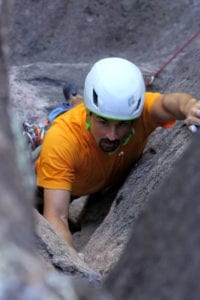
![]() Usually, when a crag is discovered on private land, climbers have to hold their breath that the owners — often out of fear of liability — don’t close it to climbing. See, usually, it’s the climbers who have the vision, seeing a slab of rock as a doorway to a rare and challenging form of self-exploration, of interacting with nature, and it’s the landowners who can have a difficult time grasping it. Their minds, understandably, filled with thoughts of lawsuits should some crazy climber dude fall on their ass. But Jim didn’t just see the opportunities that fell in front of him, a task challenging enough for most of us. He hunted after new ideas the way climbers like Utah climbing legends James Garrett and Bill Boyle hunt after new terrain.
Usually, when a crag is discovered on private land, climbers have to hold their breath that the owners — often out of fear of liability — don’t close it to climbing. See, usually, it’s the climbers who have the vision, seeing a slab of rock as a doorway to a rare and challenging form of self-exploration, of interacting with nature, and it’s the landowners who can have a difficult time grasping it. Their minds, understandably, filled with thoughts of lawsuits should some crazy climber dude fall on their ass. But Jim didn’t just see the opportunities that fell in front of him, a task challenging enough for most of us. He hunted after new ideas the way climbers like Utah climbing legends James Garrett and Bill Boyle hunt after new terrain.
Driving around the St. George area, Jim kept seeing climbers clinging to steep sandstone walls out in the desert. It didn’t take long for him to put two and two together. He owned a canyon that wasn’t being used. Climbers were, it seemed, always looking for new crags to develop, the Snow Canyon bolting moratorium serving as an example of the challenges climbers faced.
![]() One day while driving past Black Rocks, small basalt cliffs sitting at the top of a shallow ravine which can be seen from highway 18, Jim pulled over and invited a group of climbers to come check out his own little basalt canyon. Among those climbers was Todd Goss, arguably the most prolific route developer in the area at the time (now author to several Southern Utah rock climbing guide books and owner of Paragon Adventure), and together they turned Jim’s overgrown, trash-filled canyon into the first private outdoor climbing park in the nation.
One day while driving past Black Rocks, small basalt cliffs sitting at the top of a shallow ravine which can be seen from highway 18, Jim pulled over and invited a group of climbers to come check out his own little basalt canyon. Among those climbers was Todd Goss, arguably the most prolific route developer in the area at the time (now author to several Southern Utah rock climbing guide books and owner of Paragon Adventure), and together they turned Jim’s overgrown, trash-filled canyon into the first private outdoor climbing park in the nation.
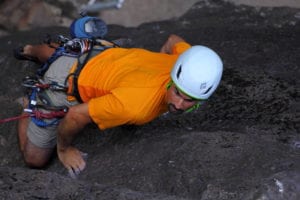 There were months of digging up weeds and clearing out brush. They had to haul an old car sans engine out from the middle of the canyon. Though Bosse Attwell points out that they were careful not to change the land more than necessary. “We try to preserve everything in here that we can. We don’t go cutting down trees just because they’re in our way.” Much like James Cottam had to build the original pool himself, the manual labor required to clean the canyon Jim did himself. The Bosses would travel from California, where the couple lived, around Thanksgiving and Christmas to continue the work. “We would come here several weeks during the winter … in our camper and everyday we’d go out and trim and burn.” The route development Jim left to Goss and the rest of the Southern Utah climbing community. Speaking of the work Goss did bolting routes in Crawdad Canyon, Boss Attwell says, “He has been, really, the reason why it is what it is today.” Though Goss is quick to direct the praise back onto Jim.
There were months of digging up weeds and clearing out brush. They had to haul an old car sans engine out from the middle of the canyon. Though Bosse Attwell points out that they were careful not to change the land more than necessary. “We try to preserve everything in here that we can. We don’t go cutting down trees just because they’re in our way.” Much like James Cottam had to build the original pool himself, the manual labor required to clean the canyon Jim did himself. The Bosses would travel from California, where the couple lived, around Thanksgiving and Christmas to continue the work. “We would come here several weeks during the winter … in our camper and everyday we’d go out and trim and burn.” The route development Jim left to Goss and the rest of the Southern Utah climbing community. Speaking of the work Goss did bolting routes in Crawdad Canyon, Boss Attwell says, “He has been, really, the reason why it is what it is today.” Though Goss is quick to direct the praise back onto Jim.
![]()
![]()
![]() The teamwork between the Bosses and the climbing community helped Crawdad Canyon begin to rise from its own debris. Sadly, in the fall of ’98, Jim Bosse passed away. He had started something beautiful and unique. In an age where people too often can’t leave well enough alone, building something mediocre on the foundation of something great, suckling off its genius to elevate their half-assed attempt to create something new — usually burying the original creation in the process — Jim took something spectacular, an oasis in the desert, a social center steeped in local history, and managed to make it even better.
The teamwork between the Bosses and the climbing community helped Crawdad Canyon begin to rise from its own debris. Sadly, in the fall of ’98, Jim Bosse passed away. He had started something beautiful and unique. In an age where people too often can’t leave well enough alone, building something mediocre on the foundation of something great, suckling off its genius to elevate their half-assed attempt to create something new — usually burying the original creation in the process — Jim took something spectacular, an oasis in the desert, a social center steeped in local history, and managed to make it even better.
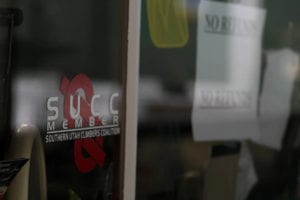
Maybe that’s why the bond between the climbing community and Crawdad Canyon is so strong. It’s a place they weren’t only warmly welcomed but enthusiastically invited to help transform, to be partners in Jim’s powerful vision. So when business concerns started to pose a problem, the recently formed Southern Utah Climbers Coalition (SUCC) stepped up as a nonprofit to handle the canyon’s liability insurance, freeing the Bosses from the burden of that responsibility. SUCC leases the canyon walls from Susan Bosse Attwell and Morris Attwell.
This unique and, really, elegant solution to what is most private land owners’ biggest fear showed the way for other privately owned outdoor climbing areas. Bosse Attwell notes that they have received many calls from both private land owners and municipalities asking how they pulled off what they have with Crawdad Canyon.
Crawdad Canyon isn’t special only for the way in which it was created. The rock itself, and the routes that have been developed on them, are considered world class. As Morris notes, “We get a lot of people from around the world coming in. We had some people from Chili … they raved about the basalt rock.” Bosse Attwell recalled numerous occasions where foreigners had made the trip to Southern Utah to visit Zion National Park but made sure that if they could only hit one other location on the trip it would be Crawdad Canyon.
Many climbers from other states return year after year. That seems to be Crawdad’s secret: It keeps pulling people back, like a dream you try to fall back asleep to get just a little more of. Bosse Attwell told me about a neighbor who has been swimming in Veyo Pool for 50 years. Two of the Cottam’s granddaughters work in the snack shop, carrying on their family connection to the canyon and its pool.
This hidden oasis in the Southern Utah desert is a legacy all its own, a legacy that would have ended well before its time were it not for the vision of Jim Bosse, a vision that’s helped to start changing the way private land owners across the country are looking at the relationship between their land and the climbing community.
I asked Susan Bosse Attwell how she thought Jim would feel about what Crawdad Canyon had become since his passing. “Jim,” she said, “I think he’d be thrilled. I think there would have been even more directions he would have taken things.” To which Morris cut in with a laugh, “Yeah, when I see ‘im in the afterlife, I’m gunna whack him for not leaving some notes.”
And that is, perhaps, Jim Bosse’s legacy: that there is always something more that can be done — that as good as things are, if you have the vision, love, and commitment to do it right, things can always be made better.
This article is an excerpt from “Utah Sport Climbing: Stories and Reflections on the Bolting of the Beehive State” forthcoming Jan. 2017 from The History Press.




